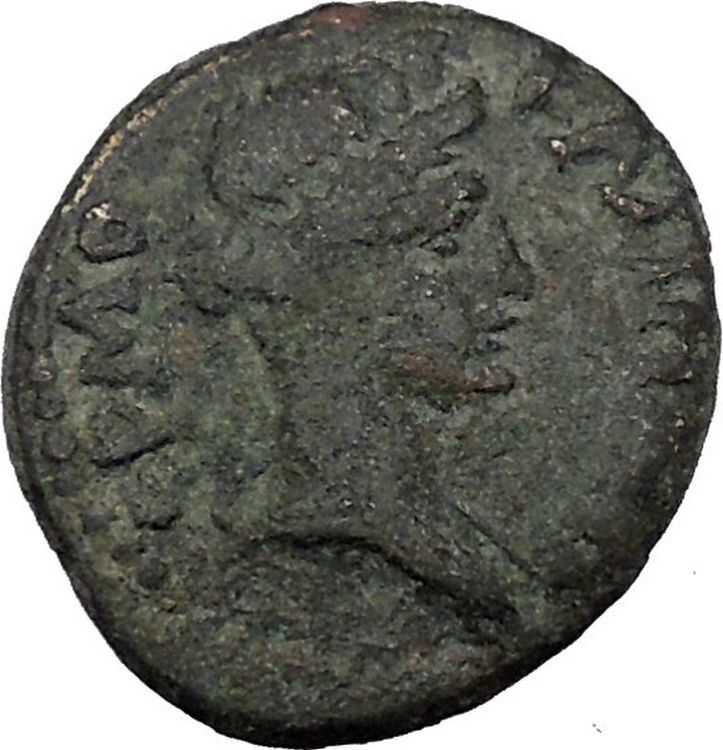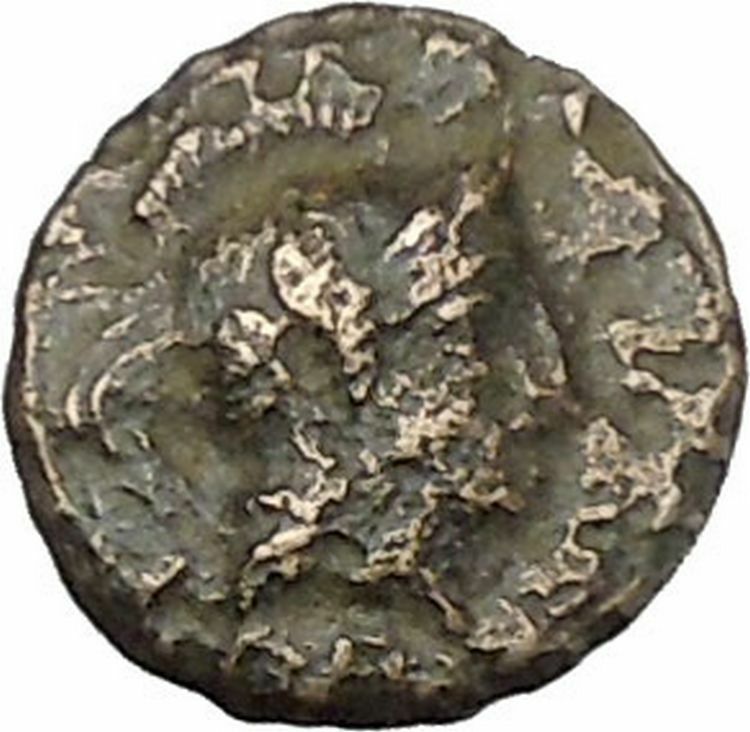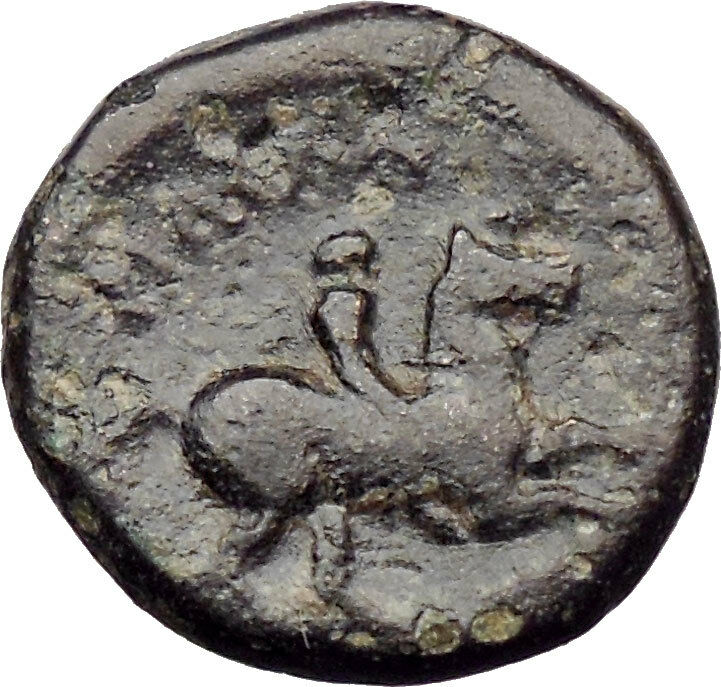under Agathocles: Tyrant of Syracuse 317-289, King of Sicily 304-289 B.C.
Bronze 12mm (1.97 grams) Struck circa 305-295 B.C.
Reference: HGC 2, 1509; CNS II, no. 118; Sear 1204; B.M.C. 2.414;SNG ANS 752 (Fourth Democracy); SNG
Morcom 752
Head of Athena left, in crested Corinthian helmet.
ΣYPAKOΣIΩN, Winged thunderbolt.
When in it’s foundations that the
city of Syracuse only consisted of the island of Ortygia, that island was said
to have been the home of the nymph Arethusa. She had been a chaste, faithful
attendant of Artemis. It is said that she got the unwanted attentions from the
river god, Alpheios, while bathing in his Peloponnesian stream. Artemis hid her
in a cloud in an attempt to save her, however she sweated so profusely out of
fear that she was transformed into a stream. Artemis broke apart the ground to
allow her to escape. She found her way to the island of Ortygia where she became
the fountain on that island.
You are bidding on the exact
item pictured, provided with a Certificate of Authenticity and Lifetime
Guarantee of Authenticity.

Athena
or Athene (Latin:
Minerva
),
also referred to as Pallas Athena, is the goddess of war, civilization,
wisdom, strength, strategy, crafts, justice and skill in
Greek mythology
.
Minerva
,
Athena’s Roman incarnation, embodies similar attributes. Athena is also a shrewd
companion of heroes
and the goddess
of heroic
endeavour. She is the
virgin
patron of Athens
.
The Athenians built the
Parthenon
on the Acropolis of her namesake city, Athens, in her honour (Athena Parthenos).
Athena’s cult as the patron of Athens seems to have existed from the earliest
times and was so persistent that archaic myths about her were recast to adapt to
cultural changes. In her role as a protector of the city (polis),
many people throughout the Greek world worshiped Athena as Athena Polias
(“Athena of the city”).
Athens
and Athena bear etymologically connected names.
Agathocles (361-289
BC), (Greek name
Ἀγαθοκλῆς (Agathokles): derived from αγαθός (agathos)
good and κλέος (kleos) glory), was
tyrant
of
Syracuse
(317-289 BC) and king of
Sicily
(304-289
BC).
//
Biography
Agathocles was born at Thermae
Himeraeae
(modern name
Termini Imerese
) in Sicily. The son of a
potter
who
had moved to Syracuse in about 343 BC, he learned his father’s trade, but
afterwards entered the army. In
333 BC
he
married the widow
of his patron Damas, a distinguished and wealthy citizen. He was twice
banished
for
attempting to overthrow the
oligarchical
party in Syracuse.
In 317 BC
he
returned with an army of
mercenaries
under a solemn oath to observe the
democratic
constitution
which was then set up. Having banished or murdered some 10,000
citizens, and thus made himself master of Syracuse, he created a strong army and
fleet and subdued the greater part of Sicily.
War with Carthage
followed. In 311 BC Agathocles was
besieged
and
defeated in Syracuse in
the battle of Himera
. After defeat in 310 BC he took the desperate resolve
of breaking through the
blockade
and attacking the enemy in
Africa
. In
Africa he concluded the treaty with
Ophellas
,
ruler of Cyrenaica
. After several victories he was at last completely defeated (307
BC) and fled secretly to Sicily.
After concluding peace with Carthage in
306 BC
,
Agathocles styled himself king of Sicily in
304 BC
, and
established his rule over the
Greek
cities of
the island more firmly than ever. A peace treaty with Carthage left him in
control of Sicily east of the
Halycus River
. Even in his old age he displayed the same restless energy,
and is said to have been contemplating a fresh attack on Carthage at the time of
his death.
His last years were plagued by ill-health and the turbulence of his grandson
Archagathus
, at whose instigation he is said to have been
poisoned
(by
his
eromenos
, Menon of Ægista, who poisoned the tooth-cleaning quill);[1]
according to others, he died a natural death. He was a born leader of
mercenaries, and, although he did not shrink from cruelty to gain his ends, he
afterwards showed himself a mild and popular “tyrant.” Agathocles restored the
Syracusan democracy on his death bed and did not want his sons to succeed him as
king.
The historian Justin says that Agathocles was born in poverty but very early
in life parlayed his remarkable beauty into a career as a prostitute, first for
men, and later, after puberty, for women, then made a living by robbery before
becoming a soldier.
Agathocles married
Theoxena
, stepdaughter of
Ptolemy I of Egypt
. His daughter
Lanassa
married King
Pyrrhus of Epirus
.
Legacy
Agathocles was cited as from the lowest, most abject condition of life and as
an example of “those who by their crimes come to be princes” in Chapter VIII of
Niccolò Machiavelli
’s treatise on politics,
The Prince
(1513). He was described as behaving as a criminal at every stage of his career.
However, he came to “glory” as much as he did brutality by repelling invading
Carthaginians and winning the loyalty of the denizens of his land. However, many
later disapproved of his actions, including to an extent Machiavelli, who
claimed “It cannot be called prowess to kill fellow-citizens, to betray friends,
to be treacherous, pitiless, irreligious.”[2].
Machiavelli, though, merely means that Agathocle’s actions do not exemplify
prowess, as he does with many other examples in Chapter XV. He actually admired
Agothocles for his brutality, but criticized him for being so cruel in public
and thus losing the people’s trust.
Syracuse pronounced,
Sicilian
: Sarausa, is a historic
city in
southern Italy
, the
capital
of the
province of Syracuse
. The city is famous for its rich Greek history,
culture
,
amphitheatres
,
architecture
and association to
Archimedes
,
playing an important role in ancient times as one of the top powers of the
Mediterranean
world; it is over 2,700 years old. Syracuse is located in the
south-east corner of the island of
Sicily
, right
by the Gulf of Syracuse next to the
Ionian Sea
.
The city was founded by
Ancient Greek
Corinthians
and became a very powerful
city-state
.
Syracuse was allied with
Sparta
and
Corinth
,
exerting influence over the entire
Magna Grecia
area of which it was the most important city. Once
described by Cicero
as “the greatest Greek city and the most beautiful of them all”, it later became
part of the
Roman Republic
and
Byzantine Empire
. After this
Palermo
overtook it in importance, as the capital of the
Kingdom of Sicily
. Eventually the kingdom would be united with the
Kingdom of Naples
to form the
Two Sicilies
until the
Italian unification
of 1860.
In the modern day, the city is listed by
UNESCO
as a
World Heritage Site
along with the
Necropolis of Pantalica
. In the central area, the city itself has a
population of around 125,000 people. The inhabitants are known as Siracusans,
and the local language spoken by its inhabitants is the
Sicilian language
. Syracuse is mentioned in the
Bible
in the
Acts of the Apostles
book at 28:12 as
Paul
stayed there.[2]
The patron saint
of the city is
Saint Lucy
;
she was born in Syracuse and her feast day,
Saint Lucy’s Day
, is celebrated on 13 December.
Greek period
Syracuse and its surrounding area have been inhabited since ancient times, as
shown by the findings in the villages of Stentinello, Ognina, Plemmirio,
Matrensa, Cozzo Pantano and Thapsos, which already had a relationship
with
Mycenaean Greece
.
Syracuse was founded in 734 or 733 BC by Greek settlers from
Corinth
and Tenea
,
led by the oecist (colonizer)
Archias
, who called it Sirako, referring to a nearby salt marsh. The
nucleus of the ancient city was the small island of Ortygia. The settlers
found the land fertile and the native tribes to be reasonably well-disposed to
their presence. The city grew and prospered, and for some time stood as the most
powerful Greek city anywhere in the
Mediterranean
. Colonies were founded at
Akrai
(664 BC),
Kasmenai
(643 BC),
Akrillai
(VII century BC), Helorus
(VII century BC) and
Kamarina
(598 BC). The descendants of the first colonist, called Gamoroi, held the
power until they were expelled by the Killichiroi, the lower class of the
city. The former, however, returned to power in 485 BC, thanks to the help of
Gelo, ruler of
Gela. Gelo himself
became the despot of the city, and moved many inhabitants of Gela, Kamarina and
Megera to Syracuse, building the new quarters of
Tyche
and
Neapolis
outside the walls. His program of new constructions included a new
theater, designed by
Damocopos
, which gave the city a flourishing cultural life: this in turn
attracted personalities as
Aeschylus
,
Ario of
Metimma
, Eumelos of
Corinth
and
Sappho
, who had
been exiled here from
Mytilene
.
The enlarged power of Syracuse made unavoidable the clash against the
Carthaginians
, who ruled western Sicily. In the
Battle of Himera
, Gelo, who had allied with Theron of
Agrigento
,
decisively defeated the African force led by
Hamilcar
. A
temple
,
entitled to Athena
(on the site of the today’s Cathedral), was erected in the city to commemorate
the event
Gelon was succedeed by his brother
Hiero
, who
fought
against the
Etruscans
at Cumae
in 474 BC. His rule was eulogized by poets like
Simonides of Ceos
,
Bacchylides
and Pindar
, who visited his court. A democratic regime was introduced by
Thrasybulos
(467 BC). The city continued to expand in
Sicily
,
fighting against the rebellious
Siculi
, and on the
Tyrrhenian Sea
, making expeditions up to
Corsica
and
Elba. In the late
5th century BC, Syracuse found itself at war with
Athens
, which
sought more resources to fight the
Peloponnesian War
. The Syracusans enlisted the aid of a general from
Sparta
, Athens’
foe in the war, to defeat the Athenians, destroy their ships, and leave them to
starve on the island (see
Sicilian Expedition
). In 401 BC, Syracuse contributed a force of 3,000
hoplites
and a general to
Cyrus the Younger
‘s
Army of the Ten Thousand
.
Then in the early 4th century BC, the
tyrant
Dionysius the Elder
was again at war against
Carthage
and, although losing Gela and Camarina, kept that power from capturing the whole
of Sicily. After the end of the conflict Dionysius built a massive fortress on
the Ortygia
island of the city and 22 km-long walls around all of Syracuse. Another period
of expansion saw the destruction of
Naxos
, Catania
and Lentini
, then Syracuse entered again in war against Carthage (397 BC). After
various changes of fortune, the Carthaginians managed to besiege Syracuse
itself, but were eventually pushed back by a pestilence. A treaty in 392 BC
allowed Syracuse to enlarge further its possessions, founding the cities of
Adrano, Ancona
,
Adria
, Tindari
and Tauromenos, and conquering
Reggio Calabria
on the continent. Apart from his battle deeds, Dionysius was
famous as a patron of art, and
Plato
himself
visited Syracuse several times.
His successor was
Dionysius the Younger
, who was however expelled by
Dion
in 356 BC. But the latter’s despotic rule led in turn to his expulsion,
and Dionysius reclaimed his throne in 347 BC. A democratic government was
installed by Timoleon
in 345 BC. The long series of internal struggles had weakened
Syracuse’s power on the island, and Timoleon tried to remedy this, defeating the
Carthaginians in 339 BC near the
Krimisos
river. But the struggle among the city’s parties restarted after
his death and ended with the rise of another tyrant,
Agathocles
,
who seized power with a coup in 317 BC. He resumed the war against Carthage,
with alternate fortunes. He however scored a moral success, bringing the war to
the Carthaginians’ native African soil, inflicting heavy losses to the enemy.
The war ended with another treaty of peace which did not prevent the
Carthaginians interfering in the politics of Syracuse after the death of
Agathocles (289 BC). The citizens called
Pyrrhus of Epirus
for help. After a brief period under the rule of Epirus,
Hiero II
seized power in 275 BC.
Hiero inaugurated a period of 50 years of peace and prosperity, in which
Syracause became one of the most renowned capitals of Antiquity. He issued the
so-called Lex Hieronica, which was later adopted by the Romans for their
administration of Sicily; he also had the theater enlarged and a new immense
altar
, the “Hiero’s
Ara”, built. Under his rule lived the most famous Syracusan, the
natural philosopher
Archimedes
.
Among his many inventions were various military engines including the
claw of Archimedes
, later used to resist the
Roman
siege of 214 BC–212 BC. Literary figures included
Theocritus
and others.
Hiero’s successor, the young
Hieronymus
(ruled from 215 BC), broke the alliance with the Romans after
their defeat at the
Battle of Cannae
and accepted
Carthage
‘s
support. The Romans, led by consul
Marcus Claudius Marcellus
,
besieged the city
in 214 BC. The city held out for three years, but fell in
212 BC. It is believed to have fallen due to a peace party opening a small door
in the wall to negotiate a peace, but the Romans charged through the door and
took the city, killing Archimedes in the process.
From
Roman domination to the Middle Ages
Though declining slowly by the years, Syracuse maintained the status of
capital of the Roman government of Sicily and seat of the
praetor
. It
remained an important port for the trades between the Eastern and the Western
parts of the Empire.
Christianity
spread in the city through the efforts of
Paul of Tarsus
and Saint Marziano, the first bishop of the city, who made it
one of the main centres of
proselytism
in the West. In the age of the persecutions massive
catacombs
were carved, whose size is second only to those of Rome.
After a period of
Vandal
rule, Syracuse and the island was recovered by
Belisarius
for the
Byzantine Empire
(31 December 535). From 663 to 668 Syracuse was the seat of
Emperor Constans II
, as well as metropolis of the whole Sicilian Church.
Another siege in 878, resulted in the city coming under two centuries of
Muslim
rule. The
capital was moved from Syracuse to
Palermo
. The
Cathedral was converted into a
mosque
and the
quarter on the Ortygia island was gradually rebuilt along Islamic styles. The
city, nevertheless, maintained important trade relationships, and housed a
relatively flourishing cultural and artistic life: several Arab poets, including
Ibn Hamdis
,
the most important Sicilian poet of the 12th century, flourished in the city.
In 1038, the Byzantine general
George Maniaces
reconquered the city, sending the relics of St. Lucy to
Constantinople
. The eponymous castle on the cape of Ortygia bears his name,
although it was built under the
Hohenstaufen
rule. In 1085 the
Normans
entered Syracuse, one of the last
Arab
strongholds, after a summer-long siege by
Roger I of Sicily
and his son
Jordan of Hauteville
, who was given the city as count. New quarters were
built, and the cathedral was restored, as well as other churches.
In 1194
Henry VI
of Swabia
occupied Syracuse. After a short period of
Genoese
rule (1205–1220), which favoured a rise of trades, Syracuse was
conquered back by emperor
Frederick II
. He began the construction of the
Castello Maniace
, the Bishops’ Palace and the Bellomo Palace. Frederick’s
death brought a period of unrest and feudal anarchy. In the struggle between the
Anjou
and
Aragonese
monarchies, Syracuse sided with the Aragonese and defeated the
Anjou in 1298, receiving from the Spanish sovereigns great privileges in reward.
The pre-eminence of baronal families is also shown by the construction of the
palaces of Abela
,
Chiaramonte
, Nava
,
Montalto
.









